Most people who get guinea pigs as pets bathe them just like anyone used to give baths to their infants. But do guinea pigs like water that much? Do they even know how to swim?
Can guinea pigs swim in a bathtub? Guinea pigs can swim in a bathtub. However, guinea pigs typically don’t like swimming, they don’t like to get wet, and they only do it when it’s necessary.
You will experience your guinea pig swimming if you decide to bathe them. If a guinea pig doesn’t start swimming, you can teach them.
In this article, you will know more if swimming for guinea pigs is good, reasons for taking them for a bath, if guinea pigs enjoy swimming, and many more!
Related: What Guinea Pigs Like to Do?
Table of Content
Is Swimming in a Bathtub or a Pool a Good Idea for Guinea Pigs?
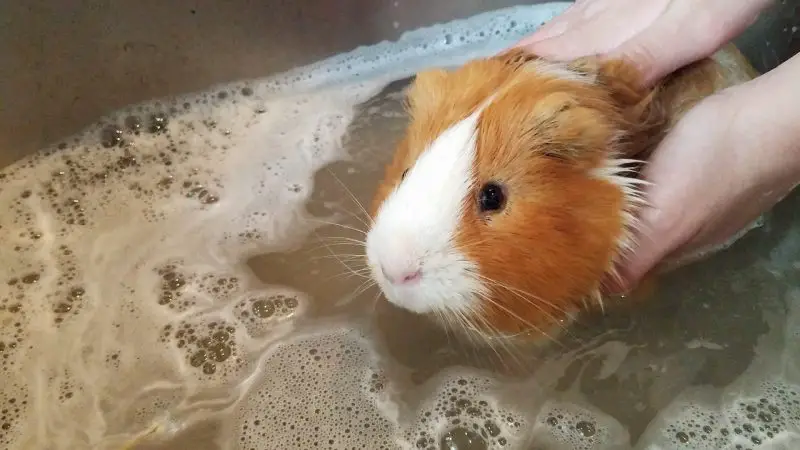
Guinea pigs usually don’t like swimming, and it’s something that they will not do on their own. They will swim only if their life is at risk for survival. It is important to remember this fact while keeping a guinea pig accustomed to living in a dry environment.
Also, they find the bathing and swimming activities traumatic. Furthermore, if the guinea pig is paddling crazily to reach the other end of the pool, it means that it doesn’t like swimming.
For these reasons, it is not a smart idea to put a guinea pig into a bathtub full of water, especially if they aren’t exposed to water in early life.
Forcing Guinea Pig to Swim Isn’t a Good Idea
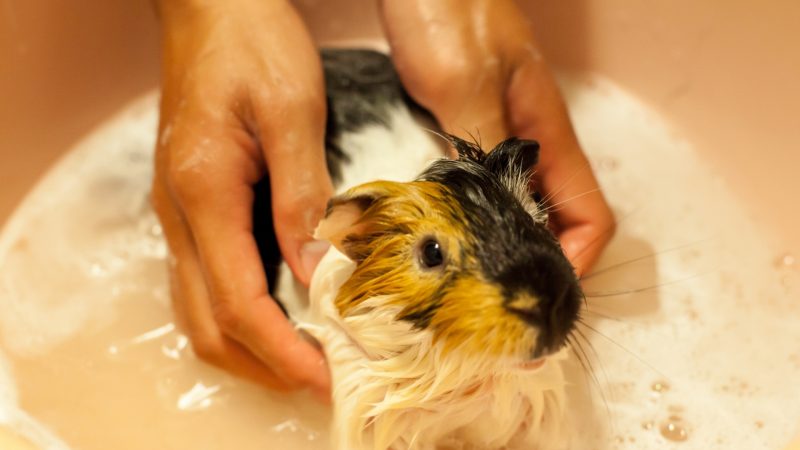
They aren’t born to swim. Their paws are small compared to their body, and their backs are delicate. It makes swimming stressful and hard for guinea pigs.
There are chances that they might get hurt. If the water level rises above the nose, it might result in an upper respiratory infection. Frequent bathing makes their skin dry out and itchy.
Some guinea pigs enjoy bathing, but most of them don’t. If you believe that the guinea pig might like water, you can use the bathtub, but you need to be very careful because the bathtub shouldn’t be huge.
To do this, fill water in the bathtub to a level that it stays below their full legs. They don’t like getting a bath often, but if a guinea pig enjoys the water, you can go for a small bathtub where a guinea pig can enjoy some swimming time.
Moreover, swimming is a therapy for guinea pigs who have weak or stiff joints. So, introducing them to water slowly in a bathtub is a great idea. You must observe their reaction, and if they are getting stressed by water, you can take them out.
Research: Do Pet Guinea Pigs Enjoy Swimming?
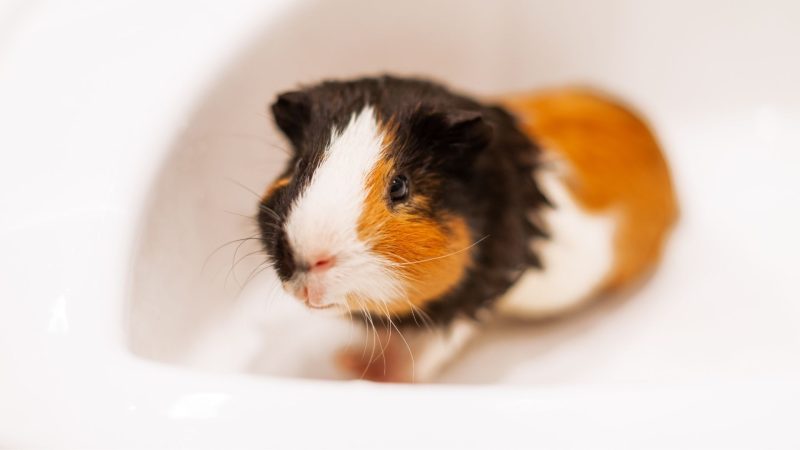
A research was conducted on testing the likelihood of guinea pigs to start swimming on their own and after being exposed to swimming. It presented a hypothesis that swimming can be stressful for guinea pigs.
Most of them got depressed after swimming. If your guinea pig enjoys swimming in a bathtub, chances are they have gained exposure to water in early life.
Can I Train the Guinea Pig to Swim?
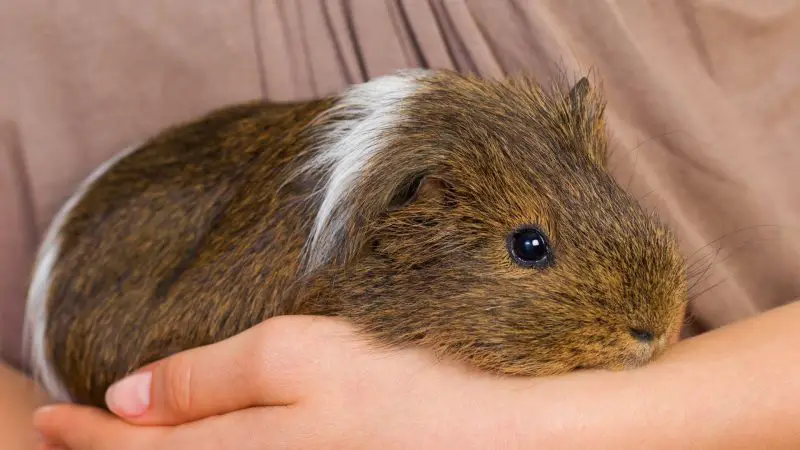
Certainly, it is not recommended to bath your pet guinea pig frequently, but it becomes unavoidable if:
- Their grease gland (located at the bottom of the tail) is more active (hint: this is specific for mature male guinea pigs).
- Guinea pig’s long hair is getting visibly soiled.
- If you want to make them look presentable for a show.
When bathing is inevitable, it might be a pleasant idea to teach your cavy in their early life that water isn’t scary or can even be fun. If it’s the first time you are letting your cavy in the bathtub, it’s better to have another person around to help you out. If the guinea pig desperately needs a thorough wash, you should follow these steps:
Step 1: Select a plastic bathtub that matches their body size so that they can come in and out as they like.
Step 2: Pour water to the base of the bath bowl but keep the level low to start with.
Step 3: Cup guinea pig in your hands’ palm and hold it gently while taking it to water; it may be helpful to speak comfortingly.
Step 4: After the initial try, admire your pet for the effort. You can consider offering a little treat to encourage their behavior.
Step 5: Keep this cycle of positive encouragement going on until all signs of resistance subside completely.
Step 6: Once you think they are comfortable enough, you can remove your hands.
Step 7: Continue offering encouragement and little delicacies while they are in the bathtub and later when they come out.
Step 8: After some time, the guinea pig will get used to the water, then you can even try a slightly deeper tub. Only after trying a slightly deeper tub, and if the guinea pig likes the water, you can now try and teach it how to swim.
To teach the guinea pig how to swim, you need to be very careful about two things:
- First, don’t leave the guinea pig unattended and take it out as soon as they show discomfort or anxiety.
- Second, don’t place your cavy in chlorinated water as it could burn their eyes and skin.
Reasons to Give Guinea Pig a Bath
Guinea pigs don’t like water or taking a bath. But there are some reasons why it becomes necessary to bathe guinea pigs. Reasons when a bath becomes inevitable for guinea pigs might include:
- They shall be given a bath if the long-haired guinea pig breed’s coat is dry and greasy.
- The main reason to get the guinea pigs in the bathtub is to clean them.
- If you want to take your guinea pig for a show.
- A bathe should be given if a guinea pig suffers from a pesticide or a fungal infection or after treating parasite infection to clean their skin.
Things to Consider When Bathing Guinea Pigs
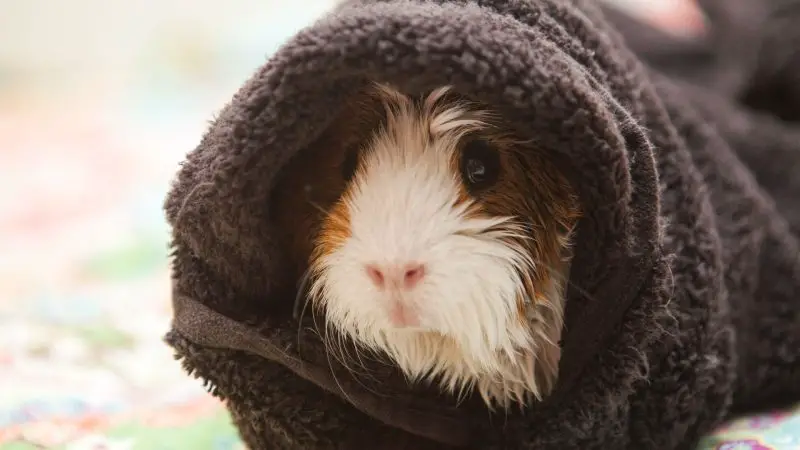
- Due to their delicateness, they quickly get cold. Guinea pigs shouldn’t be given a bath if they are suffering from respiratory illness, sick for any other reason, or live outdoors in winters.
- You need to be careful regarding what you put on their fur. Use only recommended bathing products.
- Also, make sure that the guinea pig isn’t stressed or cold, as this fear could affect their routine activities. This is significant as they are fragile creatures prone to pick up health issues quickly.
Related: Do Guinea Pigs Need Baths and Do They Enjoy Them?
How Often Can a Guinea Pig Be Given a Bath?
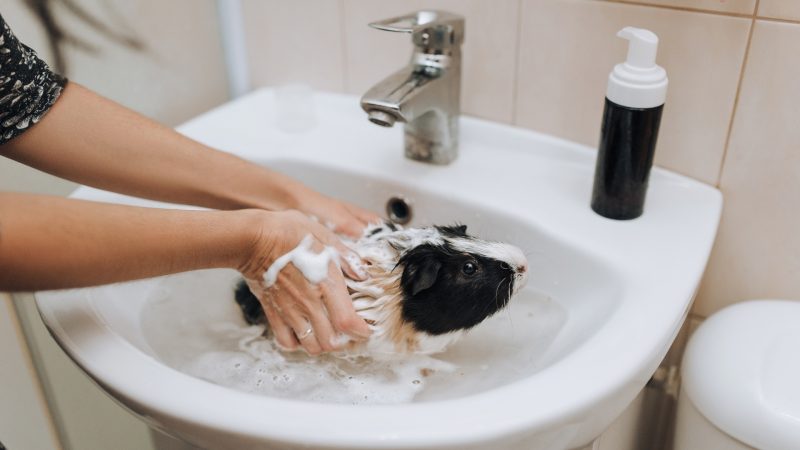
Ideally, guinea pigs should be given a bath two to three times a year, but never twice in a month. They have sensitive skin, and taking a bath frequently and swimming in the water often makes their skin dry.
This leads to hot spots and itchiness for them. Frequent exposure of their skin to water removes the natural oil found on their coat, and it affects your pet’s routine.
Related: How to Take Care of a Guinea Pig for Beginners – 9 Essential Steps to A Happy Pet
List of Sources
Laboratory Animals: Natural Infections of Guinea-Pigs
